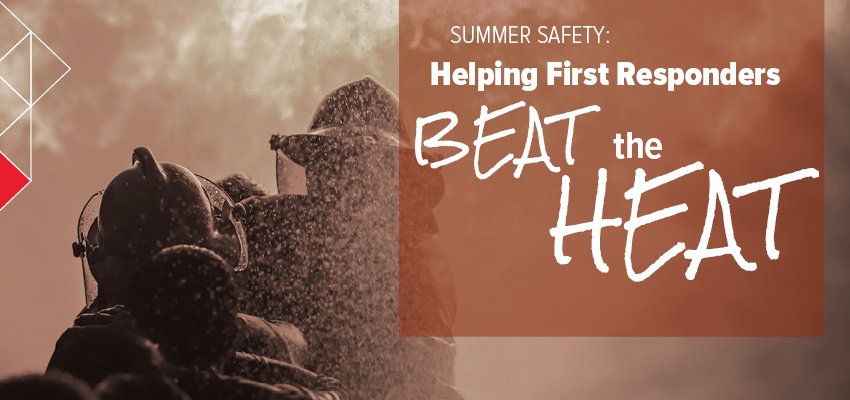Help your crew beat the heat with these important tactics
With the arrival of summer heat waves, many people find themselves hibernating indoors. For first responders, however, this is impossible. Bravely bearing the heat is a hazard of the profession, and the front lines are not air conditioned. Not only are emergency responders out in the summer heat, they’re likely out with up to 60lbs of additional equipment.

Heat exposure is one of the most important issues facing emergency responders during the summer months and into early fall. Exposure to extreme heat can have devastating tolls. Heat-related illnesses can include: heat stress, rash, cramps, syncope, exhaustion or stroke.
Fortunately, we can help avoid many of these occurrences by properly protecting our bodies during heat emergencies with these tips:
- Limit sun exposure as much as possible.
- Carry drinking water in all department vehicles, and be sure to encourage regular water intake.
- Use a sports drink to replace the minerals and salt that are lost through sweat (*if you are on a low-salt diet, however, discuss this option with your doctor before drinking).
- Use a buddy system to alternate tasks and take breaks from direct sun exposure.
Tips for on-the-scene heat emergencies:
- Understand how to deal with heat-related illnesses and have an emergency plan in place that specifies treatment options.
- Gradually work to acclimate crew members to heat exposure with frequent breaks before delving into extended heat exposure.
- Keep portable water on hand at all times and frequently take drinks.
- Work to distribute daily tasks so that crew members are both in and out of heat.
- When possible, reduce workload during hotter weather.
- Educate your team on symptoms of heat-related illnesses and watch for them carefully.
By keeping members aware of the symptoms and dangers of heat-caused illnesses, we can help to reduce their occurrence. Stay hydrated and stay aware to stay safe.
DISCLAIMER
The information contained in this blog post is intended for educational purposes only and is not intended to replace expert advice in connection with the topics presented. Glatfelter specifically disclaims any liability for any act or omission by any person or entity in connection with the preparation, use or implementation of plans, principles, concepts or information contained in this publication.
Glatfelter does not make any representation or warranty, expressed or implied, with respect to the results obtained by the use, adherence or implementation of the material contained in this publication. The implementation of the plans, principles, concepts or materials contained in this publication is not a guarantee that you will achieve a certain desired result. It is strongly recommended that you consult with a professional advisor, architect or other expert prior to the implementation of plans, principles, concepts or materials contained in this publication.
This blog post may contain the content of third parties and links to third party websites. Third party content and websites are owned and operated by an independent party over which Glatfelter has no control. Glatfelter makes no representation, warranty, or guarantee as to the accuracy, completeness, timeliness or reliability of any third party content. References to third party services, processes, products, or other information does not constitute or imply any endorsement, sponsorship or recommendation by Glatfelter, unless expressly stated otherwise.
Related posts
We asked 10 members of our VFIS Team to name one auto-related risk that they believe is underdiscussed in fire and EMS agencies. Here’s what they said.
Most volunteer fire departments rely heavily on POVs, but there are inherent risks you should know.
Establish a Emergency Vehicle Operations Program that includes driver/operator requirements to help ensure your vehicles are in the right hands.



.png?height=300&name=Glatfelter%20Team%20-%20Blog%20-%20Author%20(1).png)




Submit a Comment